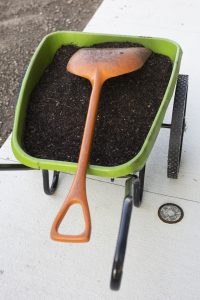The Moon
Scientists have confirmed there are preserved carbon organic molecules on the surface and in moon craters proving compost was on moon ~3 billion years ago and likely now. Data sent back from moon by SHERLOC, the Scanning Habitable with Raman and Luminescense for Organics and Chemicals is the instrument that scratches the moon surface then scans pictures back to earth. https://www.nature.com/articles/s41586-023-06143-z . The Planetary Data System https://pds.nasa.gov/ is a website full of archived data that NASA collects from planetary missions and experiments.

How to compost
All we need here on Earth is a shovel, brown leaves, twigs, grass clippings, and some kitchen scraps. With a little mixing we create beautiful dark, nutrient rich organic matter.
Decomposition is a natural phenomenon that occurs in our forest floors, pastures, bogs, swamps, meadows, and mountain tops over time. Animal carcasses, fallen leaves, critter manures, bugs and weather fluctuations. All combine with the help of microorganisms convert raw organic materials into stable humus-like material. Gardeners can have compost within few months, simply by speeding up the natural process.
 With the method of utilizing brown materials (high in carbon). Such as shredded paper, twigs, leaves, sawdust, woodchips, and green materials (high in nitrogen) such as manures, kitchen scraps, fresh grass clippings. Combine together in at least a 3’ x 3’ x 3’ sq ft. area, at the ratio 3:1, browns to green. Turn weekly, one can have finished compost within 4 – 6 months. Monitoring the temperature keeping below 140 degrees and a slightly moist texture. This provides the perfect environment for the microorganism and larger critters like millipedes, fungi, earthworms, and others to do their work (eating and pooping) as part of the decomposition process.
With the method of utilizing brown materials (high in carbon). Such as shredded paper, twigs, leaves, sawdust, woodchips, and green materials (high in nitrogen) such as manures, kitchen scraps, fresh grass clippings. Combine together in at least a 3’ x 3’ x 3’ sq ft. area, at the ratio 3:1, browns to green. Turn weekly, one can have finished compost within 4 – 6 months. Monitoring the temperature keeping below 140 degrees and a slightly moist texture. This provides the perfect environment for the microorganism and larger critters like millipedes, fungi, earthworms, and others to do their work (eating and pooping) as part of the decomposition process.
 Benefits of compost is priceless. This free natural resource provides organic fertilizer for lawns, vegetable, and flower gardens. Compost is a great soil amendment especially needed in here on Taylor County’s poor sandy soils. It can be used as mulch, potting mix, and the cream of the crop proof from intense color and healthy blooms are from watering with compost tea. Compost is out of this world when it comes to fertilizer. For more information on Composting and any other horticulture questions, contact Lisa Strange, UF/IFAS Extension Agent at lstrange@ufl.edu or 850-838-3508.
Benefits of compost is priceless. This free natural resource provides organic fertilizer for lawns, vegetable, and flower gardens. Compost is a great soil amendment especially needed in here on Taylor County’s poor sandy soils. It can be used as mulch, potting mix, and the cream of the crop proof from intense color and healthy blooms are from watering with compost tea. Compost is out of this world when it comes to fertilizer. For more information on Composting and any other horticulture questions, contact Lisa Strange, UF/IFAS Extension Agent at lstrange@ufl.edu or 850-838-3508.
 2
2
